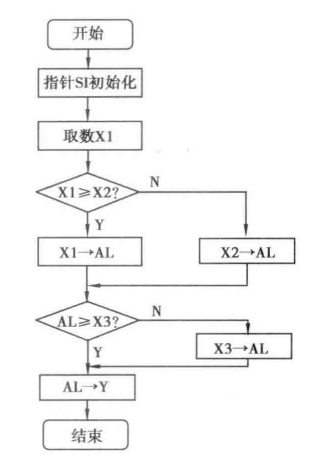Branch programming
(1) Simple branch program: two branches are obtained by judging a condition, and the judgment result of the condition determines the execution direction of the program. The disadvantage lies in the limitation of execution flow direction, for example, when the condition is a multi segmented function, the requirement cannot be satisfied.
Example: try to program the program of Y=MAX (X1, X2, x3). The program flow chart is as shown in the figure (let X1, X2, X3 be stored in three consecutive units starting with BUF, and all of them are unsigned 8-bit binary numbers)
.486
DATA SEGMENT
BUF DB 21,30,98
Y DB ?
DATA ENDS
CODE SEGMENT
ASSUME CS:CODE,DS:DATA
START: MOV AX,DATA
MOV DS,AX
LEA SI,BUF
MOV AL,[SI]
CMP AL,[SI+1]
JNB NEXT ;If X1 Not less than X2,Then turn to NEXT
MOV AL,[SI+1] ;If X1 less than X2,Will A2 Send AL
NEXT: CMP AL,[SI+2]
JNB NEXT1
MOV AL,[SI+2]
NEXT1: MOV Y,AL
MOV AH,4CH
INT 21H
CODE ENDS
END START
(2) Multi branch program: in order to solve the shortcomings of single branch program, the jump TABLE method is used to realize the design of multi branch program. For example, if we want to design a 4-branch program, define a TBLE jump TABLE in the data section, which stores 4 CASE addresses respectively. Each address occupies two units (two bytes) of memory, so the address of CASE0 is stored in the place where the address in the data segment is TBLE, that is, the TABLE head. Assuming that when CASE0 is met, skip to the place where CS segment address is 122AH, then TABLE stores 2AH, and TABLE+1 stores 12H.
| Jump table address | Entrance label address | Serial number |
|---|---|---|
| TBLE | R0 low byte + R0 high byte | 0 |
| TBLE+2 | R1 low byte + R1 high byte | 1 |
| TBLE+4 | R2 low byte + R2 high byte | 2 |
| TBLE+8 | R3 low byte + R3 high byte | 4 |
Example: try programming: INPUT the numerical sequence number 0 ~ 4 after the prompt string "INPUT", and turn to one of the five branch program segments according to the number INPUT by the keyboard. Assuming that the entry address label of each branch program segment is R0-R4, if the number n is entered, the Rn program segment will be confirmed and "OUTPUT:n" will be displayed. When the Enter key is pressed, the program ends. It is required to use the jump table to realize the transfer (each branch program segment and the main program are in the same code segment).
.486
DATA SEGMENT
TBLE DW R0,R1,R2,R3,R4 ;Automatic will Rx Fill in the offset address of
MESS1 DB 'INPUT:$' ;
MESS2 DB 'OUTPUT:$'
DATA ENDS
STACKA SEGMENT PARA STACK'STACK' ;PARA Define segment head address(20 The last 4 bits of 0)Is an integral multiple of 16
DW 50 DUP(?)
STACKA ENDS
CODE SEGMENT
ASSUME CS:CODE,DS:DATA,SS:STACKA
MAIN PROC FAR ;Subprogram definition instruction PROC,FAR Call between segments
START: PUSH DS
MOV AX,0
PUSH AX ;Stack the contents of the registers that will be used in the subprogram
MOV AX,DATA
MOV DS,AX
MOV AX,STACKA
MOV SS,AX ;16~19 Segment register description statement
AGAN: LEA DX,MESS1
MOV AH,09H
INT 21H ; DOS09 Function call
MOV AH,01H
INT 21H ;DOS01 Function call
CMP AL,0DH; Do you want to type carriage return ascii The code is 0. DH
JZ EXIT
CMP AL,'4'
JA AGAN
AND AL,0FH ;take ascii Code to number, 0~9 Corresponding hex ascii30~39
MOVZX AX,AL
SHL AX,1
MOV SI,AX
LEA DX,MESS2
MOV AH,9
INT 21H
JMP TBLE[SI] ;Turn to sequence number block,Register relative addressing
R0: MOV DL,'0'
JMP DISP
R1: MOV DL,'1'
JMP DISP
R2: MOV DL,'2'
JMP DISP
R3: MOV DL,'3'
JMP DISP
R4: MOV DL,'4'
JMP DISP
DISP: MOV AH,02H
INT 21H ;
JMP AGAN
EXIT: RET
MAIN ENDP
CODE ENDS
END START
Note: in the 01H,02H,09H functions of DOS, the input and output in the program are ASCII codes corresponding to characters, rather than direct numbers.

